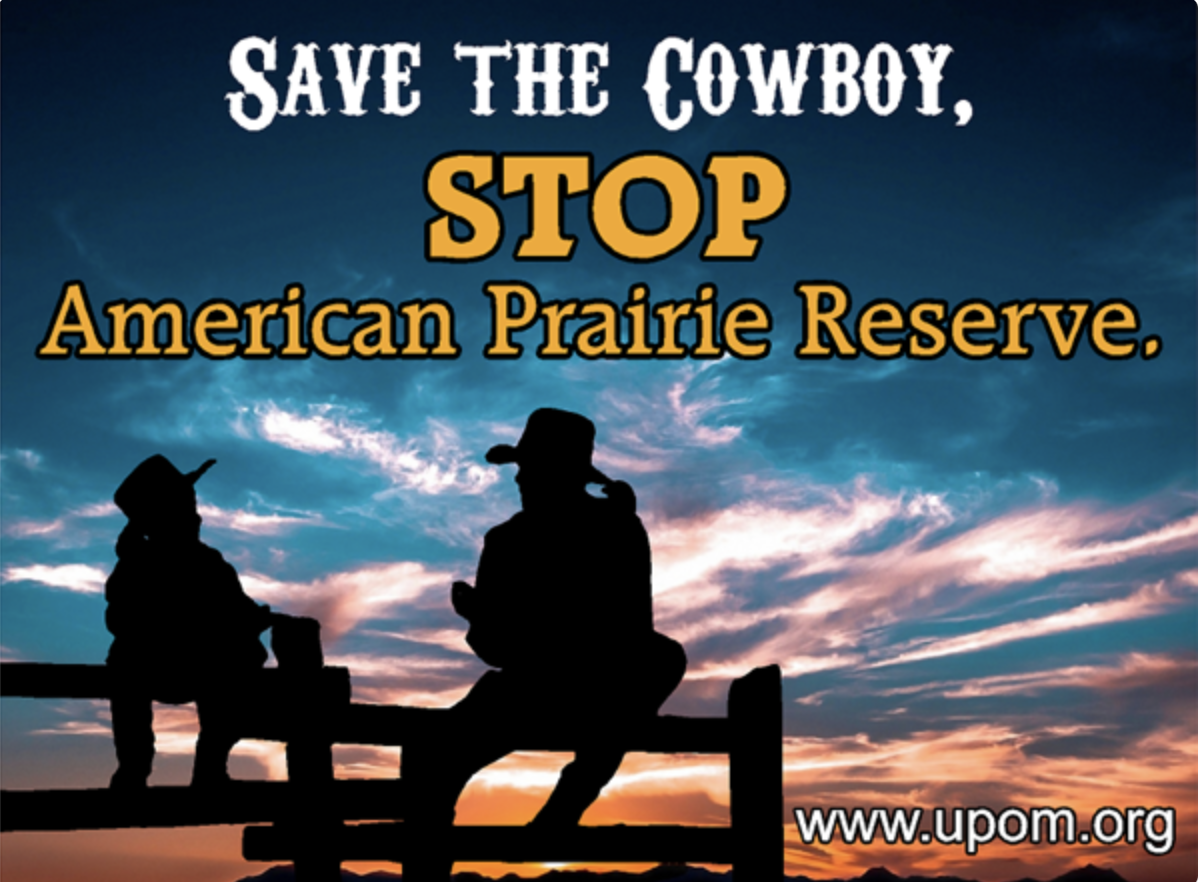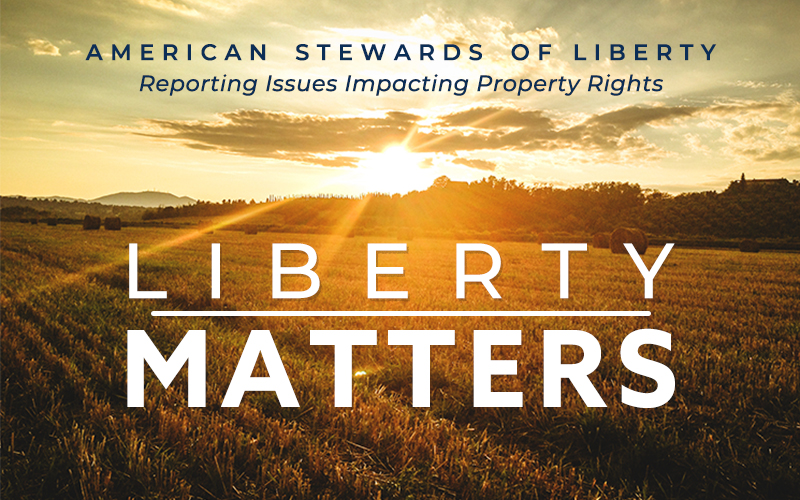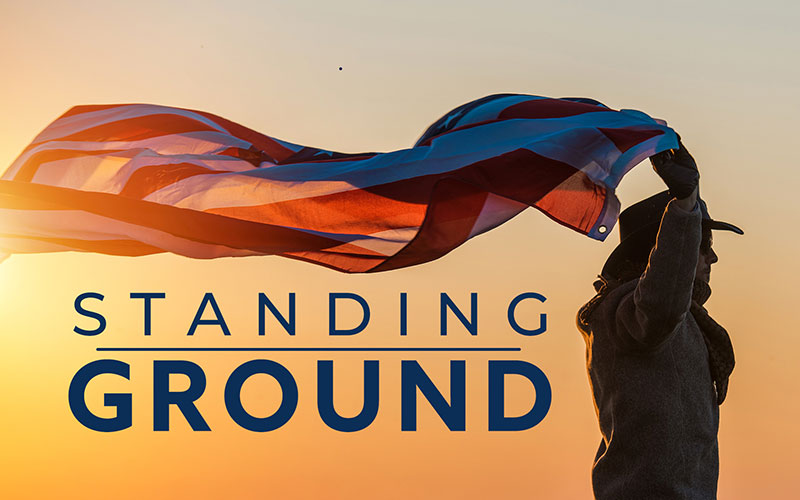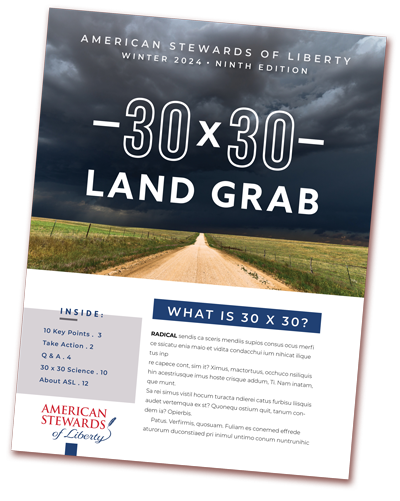In this issue…
Montanans Know How to Fight
U.S. House Resource Committee Republicans Admonish Administration
USDA Says 30 x 30 Isn’t a Land Grab, But Offers Large Incentives
30 x 30 Campaign Update
Montanans Know How to Fight
About 200 miles outside of Lewistown, Montana, you begin noticing colorful signs marking the route: “Save the Cowboy, Stop the American Prairie Reserve.” The signs, it turns out, are the creation of a remarkable group of Cowgirls who, after learning the Reserve was telling the public local ranchers were thrilled they were buying up the ranch land, decided it was past time to set the record straight.
The largest of these signs is a billboard found a few feet from the main entrance to the Reserve.
The American Prairie Reserve (APR) is attempting to amass 3.5 million acres creating the largest park in the Northern Great Plains. It would be 27 percent of a five-county region. Two of these Counties, Petroleum and Phillips, ran the numbers and concluded their local economies would be devastated.
If the APR gained the acreage they seek in these two counties alone, they would displace 179 agriculture families with just 16 APR families, eliminating from the local economy the $17.6 million dollars that come from the agriculture acreage returns and replacing this with just $3.8 million from the APR held acreage. Charitable giving from the residents of these two counties to local services and community organizations in 2015 was $484,107, compared to just $17,000 given by APR across all five counties. Volunteer hours? The two county’s residents gave 21,433 in one year. Zero came from APR. Phillips county crunched the numbers further and found that cash receipts from livestock and crop sales brought $77.8 million into the local economy, while APR generated $175,000 in visitor income.
But the APR is only part of the story.
Imagine trying to raise livestock in this beautiful area, something that has been done for many generations, while slowly being overtaken by the Charlie Russell National Wildlife Refuge (1.1 million acres), the Upper Missouri Breaks National Monument(377,000 acres), an Hell Creek Area of Environmental Concern (19,333 acres), 150 miles of a Wild and Scenic River, other various federal and state holdings, and of course the non-profit APR. It is a federal regulatory spider web of rules, conditions, and restrictions. The end game for environmentalists is to turn this area into a “Buffalo Commons” that would run from Canada, through Lewiston, and down into the Sandhills of Nebraska, fully connected and unfenced.
But this same group of Cowgirls have also proven to be more than just sign builders. Through their Save the Cowboy campaign, they developed a Negative Bison Easement that neighbors are signing ensuring if any of their lands are sold, bison are prevented from running on the property. Bison management and livestock management do not mix. Beside disease concerns that would harm livestock, the bison are harder to fence in than cattle, meaning livestock will eventually be forced off the land.
And that brings up the third most remarkable action this group of Cowgirls, and yes Cowboys, recently pursued. The United Property Owners of Montana (UPOM) suedthe Montana Fish, Wildlife and Parks, that was creating a management plan to designate parts of the area a “bison management area.” This bought the landowners critical time as the Governorship changed from Democrat to Republican and the new Governor Greg Gianforte settled the issue in favor of the ranchers. Now, there will be no bison designation for the lands in this remarkable ranching area of Montana for at least the next ten years.
It is a blow to environmentalists who sought to have the bison treated as free-roaming wildlife, rather than livestock. E & E News quoted Chamois Andersen with Defenders of Wildlife as saying, “This will roll back years of work, to be so close to having bison restored in Montana outside Yellowstone [National Park].” (“Mont. Governor Drops Bison Plan in Win for Ranchers, April 21, 2021, E & E News)
While this seasoned group of Americans who are fighting for more than their land rights, but ours as well, are breathing a collective sigh of relief, they also know this fight is not over. Nevertheless, they deserve a round of applause from landowners across this great nation.
Feel free to send a contribution to this worthy cause. They might even send you a “Save the Cowboy,” bumper sticker.
U.S. House Resource Committee Republicans Admonish Administration
In response to the 62 members of the U.S. House and Senate letter opposing 30 x 30 who requested a full briefing on the proposal (letter dated March 16, 2021), the White House finally provided Congressional staff members with a brief ten-minute presentation and a short round of questions.
While Congressional Staff focused on asking specifics about the program, the White House stated no decisions have been made. Very little, if any new information was conveyed to the members of Congress, which led to a sharply worded letter signed by every Republican member of the House Resources Committee.
In its opening paragraph, the Congressmen note:
“Administration officials, however, deflected questions, provided vague responses, or simply acknowledged inquiries as ‘really hard question[s].’ The continued lack of information heightens concern from our constituents that the Administration will use the 30 by 30 initiative to facilitate a radical federal land and water grab.”
The Republican members could not understand how the Administration endorsed specific legislation implementing the 30 x 30 goal when they could not answer basic questions like how “conservation” would be defined, what lands would be counted towards the effort, and how private land conservation would be measured.
“Despite the fact that these basic questions could not be answered during the engagement session, in February the Administration released a Statement of Administration Policy endorsing H.R. 803, the Protecting America’s Wilderness and Public Lands Act. The Administration’s endorsement stated that as ‘consistent with the recommendation of scientists that . . . the Nation must pursue a goal of conserving at least 30 percent of U.S. lands and ocean by 2030.’ It is extremely concerning that the Administration knew enough about what was “consistent” with 30 by 30 to endorse legislation being considered by the House of Representatives that would limit multiple-use and create millions of acres of new wilderness, yet did not know enough to answer rudimentary inquiries at a staff-level briefing.”
Formal authorization for the 30 x 30 program must come from Congress, which has the sole authority to manage federal lands. Although the lack of transparency on 30 x 30 should be a bipartisan concern, to date, no Democrat Representative, Senator or Governor has objected to the 30 x 30 program.
USDA Says 30 x 30 Isn’t a Land Grab, But Offers Large Incentives
USDA Secretary Vilsack has finally publicly addressed the concerns of landowners that the Biden administration’s goal to conserve 681 million acres in nine short years is not a land grab. He has made these statements while encouraging landowners to sign onto the many conservation programs offered, for which the Biden Administration has increased funding and enrollment flexibility.
“This discussion surrounding 30×30 is really off-base,” Vilsack said. “None of it involves taking over anyone’s land from them or using eminent domain. It’s not going to happen.” (“Vilsack talks Tongass protections, 30×30 rumor mill,” April 26, 2021, E & E News)
The Secretary states they will not be using eminent domain, even though the briefing the Administration recently gave congressional staff made clear they would be using “all” the tools in the toolbox, which presumably includes eminent domain. That issue aside, however, the Secretary failed to address whether the Antiquities Act, Wilderness designations, Wild and Scenic Designations, private lands with conservation easements in perpetuity, and federal land acquisitions would be employed to reach the goal, all of which have been confirmed by Administration officials.
Secretary Vilsack focused on the substantial amounts of money the department is offering for conservation programs. This week alone, the USDA has announced:
“higher payment rates, new incentives, and a more targeted focus on the program’s [conservation reserve program] role in climate change mitigation. Additionally, USDA is announcing investments in partnerships to increase climate-smart agriculture, including $330 million in 85 Regional Conservation Partnership Program (RCPP) projects and $25 million for On-Farm Conservation Innovation Trials.” (“USDA Expands and Renews Conservation Reserve Program in Effort to Boost Enrollment and Address Climate Change,” USDA Press Release, April 21, 2021)
In reality, landowners implement good land management practices every day as part of their agricultural operations. The problem, however, will be the federal strings that the new Administration will attach to these conservation programs.
For instance, critical habitat for endangered species does not affect private property “unless” there is a federal nexus, such as when a landowner participates in a program that is authorized, funded, or carried out by a federal agency. The Endangered Species Act requires all federal agencies to consult with the U.S. Fish and Wildlife Service when there are potential species’ impacts or modification of habitat as a result of the agency’s authorization, funding or carrying out of an action. (See ESA USDA Directives)
This was not a major concern for landowners under the previous Trump Administration, which worked to reduce the federal restrictions on landowners. However, our current President waited only six days after his inauguration to sign an Executive Order that initiated a new policy to conserve 30 percent of America’s lands, for which substantive details have yet to be shared with the public.
Signing up with one of these conservation programs under the new Administration, is understandably concerning to landowners.
The USDA has said these programs are simply to help landowners carry out the good work they already employ on the land. The only difference then between where we are now, and where the Biden Administration wants us to be in nine short years, is who will permanently control our land; American landowners, or the administrative state run by the agenda of the radical environmental left?
Upcoming Events
Learn more about the new Administration’s 30 x 30 program and what you can do to protect your land and community. We will be in Colorado, New Mexico and Texas in April and May, and North Dakota in June. We hope to see you on the road.
Map of Those Opposed to 30 x 30
See if your County, Governor, U.S. Representative and Senators have officially opposed 30 x 30. If they are not on the map, contact their office and make sure they stand for property rights. If we have missed an entity or elected leader, please let us know.





